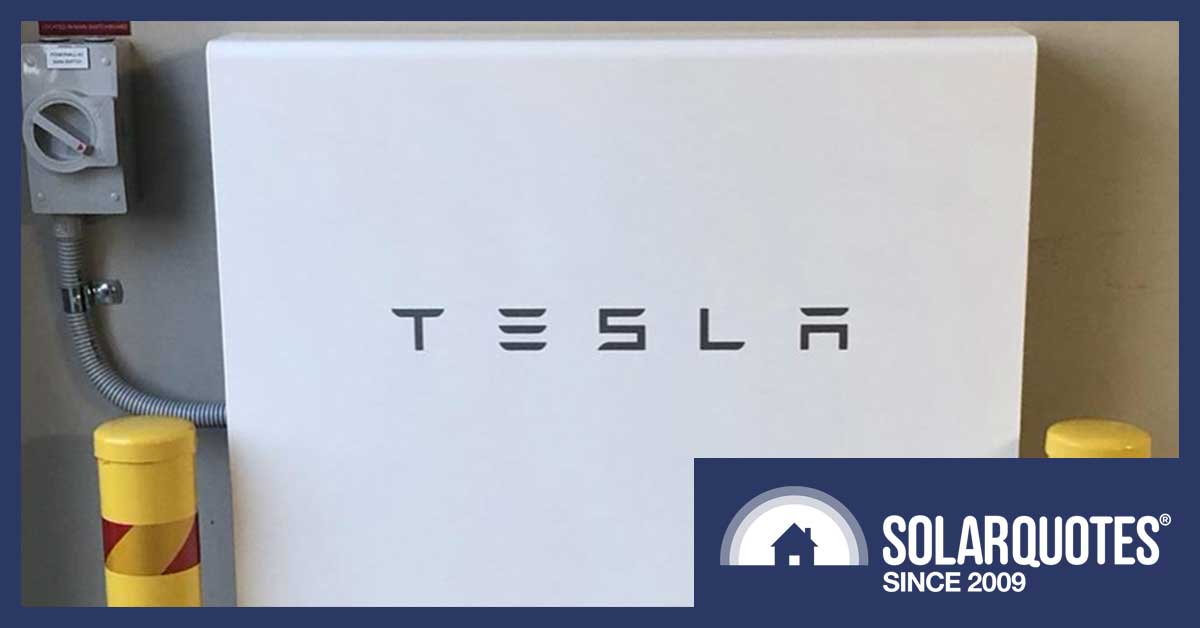
Despite promising to reduce energy storage costs, Tesla keeps increasing the price of its Powerwall home battery.
On September the 23rd I woke up at 5:00 am to listen to Elon Musk’s Battery Day announcement where the world was told Tesla would cut the cost of batteries in half by 2025. We were told they would:
- Lower the cost of battery cells.
- Lower the cost of battery factories.
- Reduce the cost of raw materials required.
So I am feeling miffed that instead of lowering the cost of Powerwall 2 Tesla has instead increased its price by $800. This is a 7% increase and more than the $650 price cut they gave in July last year.
Here’s the price of a new Powerwall according to Tesla’s Australian site at the moment: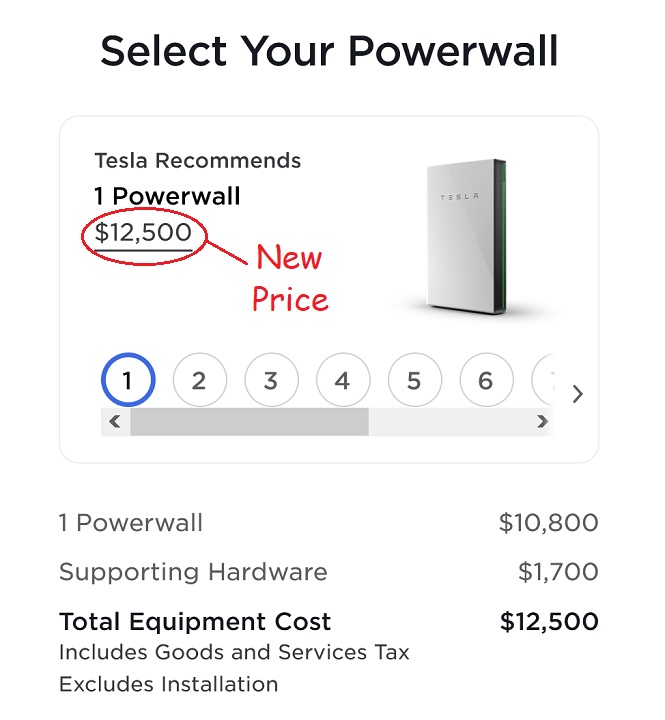
That’s not exactly how they present it. I added the red oval and Comic Sans type saying “New Price” myself.
Here’s the price they used to have:
Again, I added the stuff in red. Tesla never had a graphic up stating “Old Price” in Comic Sans.
It seems to me that if Tesla is rapidly driving down the cost of batteries then they should be decreasing the cost of the Powerwall, not pushing it up.
Powerwall Price: Ups & Downs But Mostly Ups
This graph1 show how the Tesla Powerwall 2, despite existing in a world of rapidly declining battery costs, increased its price by 36% since its launch. And that’s after adjusting for inflation:
The first figure is a little iffy, as Tesla didn’t give the price without installation; but if we use the same $1,000 price for “supporting hardware” they used a year later then its price was $9,000. Even after allowing for a little leeway on the first price it is clear the Powerwall 2 has done almost nothing but increase in price.
I don’t know why Tesla increased the price so much, but I suspect it’s because the company found making home batteries is very difficult. The Canberra Battery Test Centre’s 7th report showed that, of the 18 batteries they had tested, 83% of were faulty in some way. Faults ranged from requiring repairs or replacement to complete and utter failure to work from day one with no replacement or refund because the company went bust.
Battery Included But Not Installation
The now $12,500 price only covers the cost of the Powerwall and its gateway box and cabling that Tesla calls “supporting hardware”.

One of these images shows the Powerwall 2 and its gateway box. In a real installation, there will be cables between the two and they won’t look as neat.
Installation can easily add over $4,000 to the cost of a Powerwall, with the exact amount depending on how much work your existing switchboard and wiring requires. I know there are people who have been charged much less than that, but I’m not sure the installers doing rock bottom installations have a viable business model.
Under Australian Consumer Guarantees, those selling and installing Powerwalls will be responsible for providing a repair, replacement, or refund for any that fail during their 10 year warranty period and potentially beyond that. If Tesla goes bust, or simply become uncooperative, installers could be on the hook for a hell of a lot. If in five years time President Musk goes mad from too much wacky weed, barricades himself in the White House, and then uses the internet to turn all Powerwalls into bricks — installers who sold the Powerwalls will be on the hook for a repair, replacement, or refund. This applies no matter what happens to Tesla.
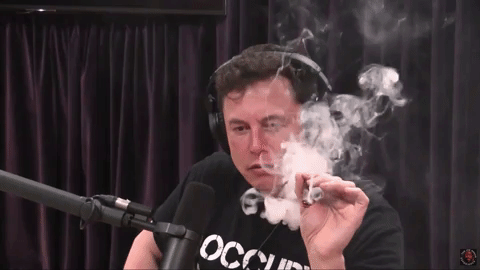
“Nah… I wouldn’t do that.”
Lower Tesla Battery Costs Don’t Apply For Powerwall
One thing I can definitely tell you about Elon Musk is the man has balls of steel.
Here’s one of them being thrown at a cybertruck:
But — besides owning many actual, physical balls of steel — Elon is also ballsy in another way. Just seven weeks ago he hyped a huge Battery Day announcement and stated to the world that Tesla would halve the cost of batteries over the next 5 years – and then in October raised the price of Tesla Powerwalls. Now that’s some chutzpah. If you’re wondering what chutzpah means its definition is killing your parents and then pleading for mercy because you’re an orphan.
In case you missed the Battery Day shindig, here’s a shot of Elon Musk and Drew Baglino, Tesla’s Vice President of Powertrain and Energy Engineering, in front of a image showing how they plan to get a 56% reduction in battery pack costs:
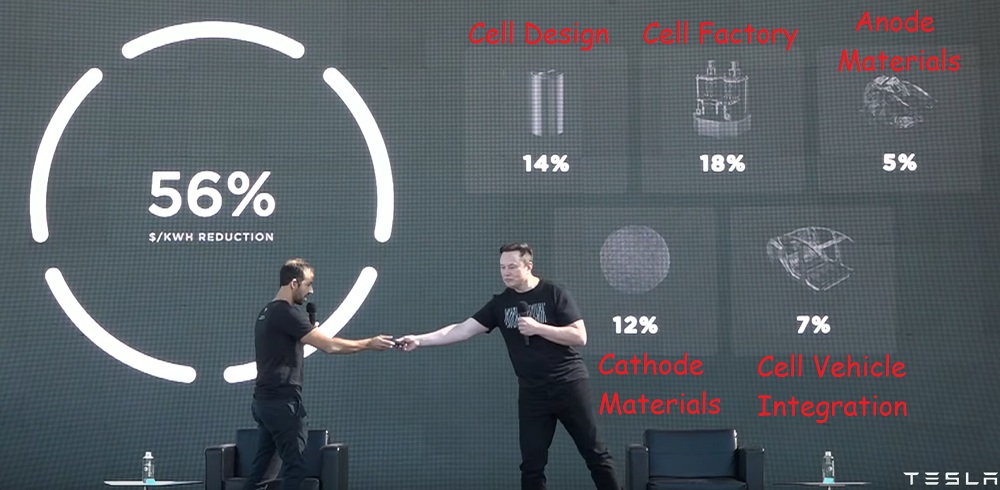
“It’s agreed then… On Libertarian Mars, cars drive you!”
Again, I am responsible for adding the red Comic Sans giving the names of the areas they intend to lower costs.
If you are thinking maybe they just happened to flash the wrong image up behind them, here’s a direct quote of what they said…
DREW BAGLINO: In addition to the improvements we’ve just said on enabling additional range and improving the structural performance of the vehicle, it is worth another 7% dollar per kilowatt-hour reduction at the battery pack level, bringing our total reductions now to 56%, dollars per kilowatt-hour.
ELON MUSK: Yeah.
I don’t know if they had Baglino say that to give Musk some kind of wiggle room if they fail to meet their stated goals, but Elon’s response wasn’t….
ELON MUSK: That’s utter bullshit, Drew.
And he didn’t even say something sarcastic like…
ELON MUSK: Yeah, sure we’ll cut battery prices by that much. Right after we finish our aerial pig project.
Instead he, the CEO of Tesla, agreed with him at a presentation focused on how they are going to cut battery pack prices.
I’m not saying that promising to massively cut battery prices and then immediately raising them with a Powerwall price hike is evil. After all, Elon Musk is a great guy. When I was six he pulled me from a burning car seconds before it exploded. I trust him with my life.
But I do think it is bad business. You’re not likely to convince investors you’re about to slash the cost of your batteries if your first move after your big Battery Day announcement about it is to jack their price up. It’s also not going to convince competitors in China and elsewhere they shouldn’t try to compete with Tesla in the home battery market because it makes it clear the Tesla talk doesn’t match the Tesla walk.
Under 3 Years For $800 Powerwall Battery Pack Cost Decrease
At the Battery Day presentation Musk and Bagalino were referring to electric car battery packs, but nearly all their cost cutting measures should apply to Powerwall packs and so their cost should also decline by around half.
If we believe Tesla will lower the price of Powerwall battery packs by almost half over 5 years then they will have to manage an average reduction of 12% per year2. If it currently costs them $200 Australian per kilowatt-hour to make a Powerwall battery pack, as it’s 14 kilowatt-hours in total, it would cost them $2,800. So after one year the cost of the battery pack should be reduced by $336. After 3 years it would be $892 less. So it would take them less than 3 years of battery cost reductions for the savings to exceed the recent $800 price hike. Since Tesla would also be lowering the cost of the electronics and other components, the time required for an $800 decrease in Powerwall 2 production cost is likely to be much less.
It Was A Sneaky Price Increase
I mentioned the Powerwall price increase occurred in October but I’m only writing about it now in November. This is because Tesla was charging more but didn’t increase the price on their site. This was a bastard move by Tesla that stunk to high heaven and I’d much prefer it if Tesla kept their stinky, high, bastards away from us.
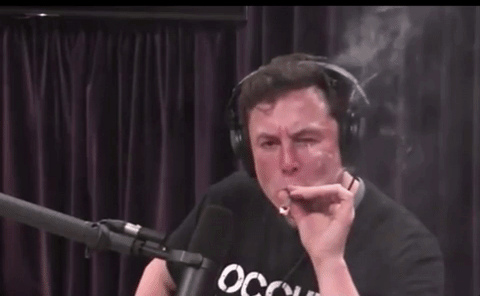
“Hey… I resemble that remark.”
Their perfidy required installers to explain to customers that Tesla had increased the price while Tesla was still showing the old price on their site. It seemed that Tesla was willing to let installers take the blame for the increase. I’m not happy about Tesla increasing the Powerwall price, but if they want to do that it’s their business — quite literally. But this sort of behaviour makes me so angry I could just about suffer a thermal runaway and vent with flame — as they say in the battery business.
US Price Also Up
One good thing I’ll say about Tesla is they have never screwed us over by charging more in Australia for their products than they do overseas. This is the price currently up on the US Tesla site:
With our 10% GST the US Powerwall price comes to $12,356 Australian dollars. While that is $144 less than what Tesla charges here it’s only a 1% difference and I’m willing to let it slide.
A strange thing I noticed about the US Tesla site is that if you tell it your electricity bill in New York is $81 US a month it recommends you get two Powerwalls. That’s pretty bizarre because electricity in New York costs about around the Australian average. So by Tesla US standards the typical Australian home should have multiple Powerwalls. That’s not something I recommend unless you think Elon Musk should have all the money.
A Fair Market Price?
Most companies don’t charge what they consider to be a fair price for their products. They charge what they think they can get away with. The Powerwall 2 seems to be a pretty good product. So if people are still willing to shell out for them despite the price increase, then they will be voting for the Powerwall with their wallets and Tesla will be rewarded for making a battery system that works well with extra money.
But all human beings respond to incentives and Australians do as well. With the price increase Tesla will sell fewer Powerwalls than they would have otherwise and people will buy more battery systems made in China, South Korea, and other countries that aren’t the United States of Tesla. To me it seems clear Tesla is either unwilling or unable to dominate the home battery market and are positioning themselves as a provider of premium battery systems. There is nothing wrong with a company doing this, but it doesn’t live up to the Tesla hype.
But then if Elon Musk lived up to his hype, right now we’d probably all be smoking dope on the moon.

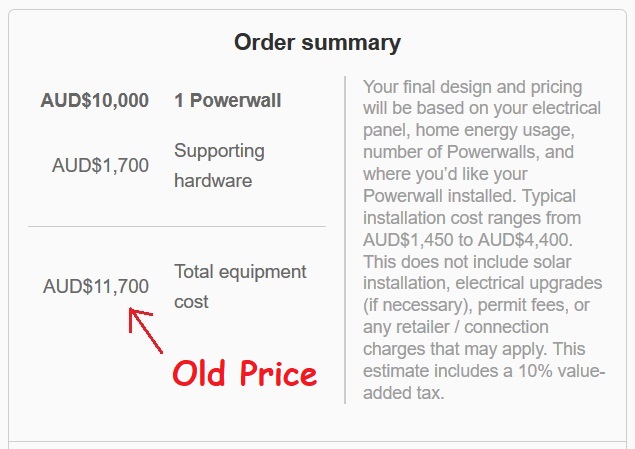
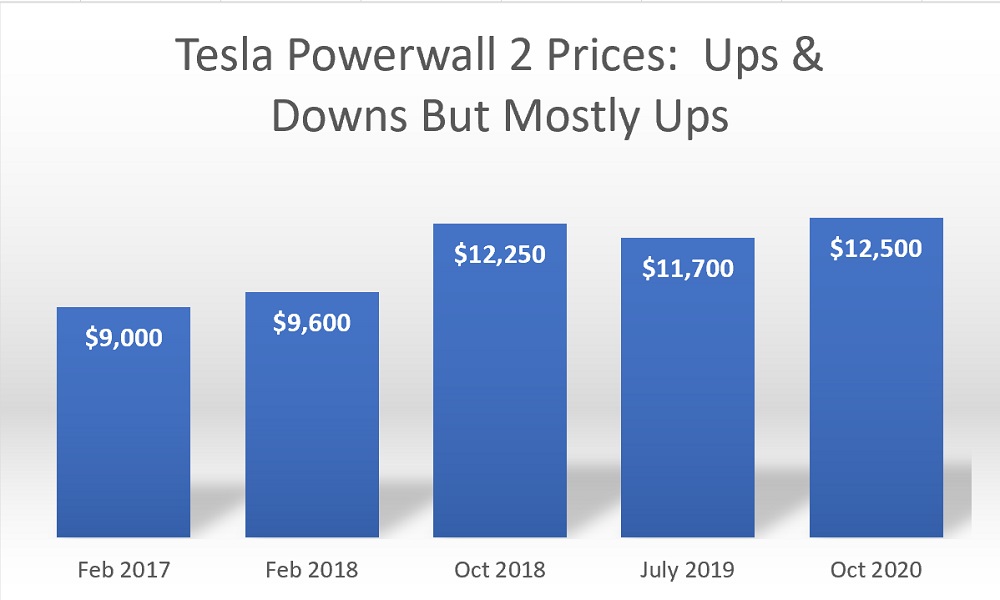
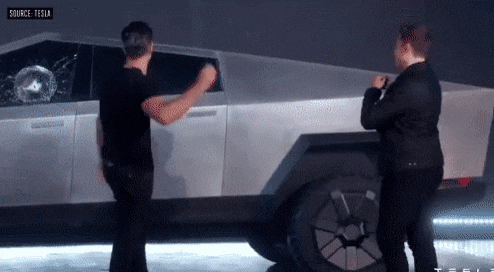
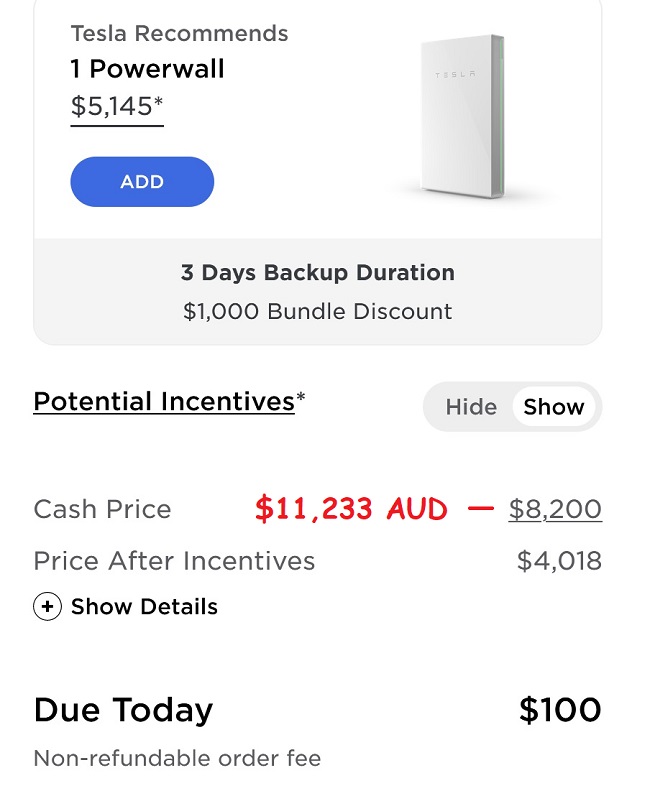
 RSS - Posts
RSS - Posts



Defiantly (sick!) won’t be rushing into battery storage… and I’m a TSLA shareholder.*
And despite having ordered a Tri-motor Cybertruck, we’re now looking at the new Lexus Electric. Can we stomach that ugly, pretentious, unnecessary grille? Maybe Toyota will come to their senses before the T-M CT arrives… .
* You may recall my kids bought me one TSLA share last Christmas.
That became five shares… now worth six times what they paid.
Gotta laff…
Why wd you be considering buying a Toyota-at-twice-the-price Lexus EV (which won’t be around for at least a year, probably longer) when it will be much more expensive than equivalent Model Y, which even in base form will have at least 50% more range? Haven’t seen anything that suggests Lexus is in any way a superior vehicle – quite the opposite. Each to their own, of course. But still…
If anyone wants to lend me these cars to try them out I’ll be more than happy to compare them. I tried the Tesla S and it was awesome:
https://www.solarquotes.com.au/blog/tesla-model-s-review/
Well first Lexus will have to build one so that will be a year… Tesla has built and sold a squillion Model Y already and they’ll be here soon (Feb 21?) so drop down to a Tesla showroom and go for a blast…
Hey Guido – where did you get that info? I don’t think there are any RHD Model Y’s until possibly late 2021 and the first lot will all most likely go to the UK. I suppose if they can ramp up production in China maybe, but I think they’ll sell al the LHD they can make. Interested to hear your take.
Toyota have had very reliable electric vehicles for years; their first hybrid came out in 1999
They have had larger batteries in their hybrids in the USA for over 5 years with plug in charging.
Are the Tesla car batteries more reliable than their home batteries??
I think you may have an issue with delayed gratification? I’m sure you watched the whole battery day thing and they didn’t say “within 2 months”. From the whole battery day thing, they are doing the whole battery in a different way from (literally) beginning to end, and they predict it will reduce costs in the medium term. It won’t be “12.5% a year”, it will be a step change in costs, and it will roll out in different ways in different products depending on their needs. They have a pilot plant now (which is actually rather large) and then they’ll scale it up.
They do what they say, so they will. Sometimes it takes longer than they say, but they do it. Sometimes quicker (Model Y).
Even Tesla is battery supply constrained, so they have to do the most they can with what they have. The answer to this is easier than cars – mostly the other EVs are pretty shit. There’s plenty of choices with Powerwall, so if you don’t like the price increase don’t buy it. Kind of like complaining about the price of iPhones…
Guido, we figured on paying AU$110K+ for the T-M CT. Have you really studied the specs on the new electric Lexus? I really doubt the mY will have 50% more range… . They may in fact be on a par.
If the mY can avoid US$ – AU$ conversion (as the Lexus will) it may be an option.
We’re not anti-Tesla… we’ve ordered a Cybertruck and we’re already ‘on the list’ for Starlink.
Yes I’ve RWD about it, everything I’ve read isn’t terribly impressive, the Lexus is a converted ICE car (which is always a bad idea) and will likely have a 50-odd kwh battery vs 70kwh for Y and given Tesla’s lead in efficiency I’d be confident saying will be at least 25% better range, probably more, and much cheaper. We won’t know of course until they build and release it but the evidence to date (Audi, Jag, that awful Merc thing) supports my view. The Y will start at a lot less than $110k no matter what, more like $80k, they’re coming from China so less sensitive to US$. Like I say, each to their own, but I can’t see anything compelling about the Lexus.
Hey Guido, the model Y I just ordered ran out of power halfway through your reassurance! Send a rescue vehicle, ASAP.
Seriously, I suspect the Lexus EV will arrive around the same time as the mY. Lexus should price it to compete… .
Re: “The Y will _start_ at a lot less than $110k no matter what, more like $80k”
That’s because no Y variant will travel 812 kms on one charge, won’t have the same towing capacity… or the potential to carry all the equipment we need. In fairness, neither will the Lexus EV… .
In fact, neither of us have any idea (yet) what the Lexus or the mY will cost when both arrive in Australia in a year’s time. I expect US demand for both vehicles to go thru’ the roof next year, when hopefully Biden’s subsidies click in. TSLA US$3K (ie., 5 X US $600) early next year(?)
Seriously hope Musk makes it through OK.
Shotgun scatter response, but I’ll go with a couple. US demand will have no impact on Oz Model Y because (reliably reported) all RHD production is being shifted to China, RHD MIC model 3s have been spotted there as have MIC model Y. Very confident Y will be here well sooner than 12 months, and betcha much, much cheaper than Lexus. Time will tell. Neither of us “know” (unless you’re in the Tesla inner circle??) but my educated guess is before mid next year because they’ll be making so many frickin cars the days of Tesla rationing supply are ending – hence MIC 3 exports to Europe. UK a decent size RHD market and when you build 1 RHD you need to make a lot (big batches are better). Is the last reference to share price? It’s currently $US408.50, certainly hope it gets a Biden boost because I bought quite a few at the equivalent of $52 🙂
There’ll be a big TSLA bounce tomorrow due to being added to the S&P 500 index. Watch this space… .
An 8% lift… then another 10% last night.
Well on the way to my prediction. Hopefully Musk’s infection is mild… .
Good thing I got my Tesla Powerwall 2 back in 2017 for $11739 fully installed with full house backup and gateway with 3G service.
People kept saying prices will drop and they say look at LED TVs and Solar PV. The same will happen to Li-ion batteries. I disagree. You cannot compare the rate of LED TVs and Solar PV costs/production performance and apply it to Li-ion batteries (or any battery basically).
If that was true, then lead acid (LA) batteries should be dirt cheap by now but they’re not and still just as expensive as lithium batteries when comparing their relative performance characteristics (more specifically the DoD).
I have not seen him saying they will lower prices… costs yes, not prices… demand through the roof so why not lift up the price?
hohohoho… and it’s not even xmas. Prices are skyrocketing because there are endless idiots lining up to pay them…. ‘Before they go up next week!’
……all encouraged by non-productive industry shills. (see also ‘Real Estate Prices’)
The
Sheep are for shearing.
So very nice of him to increase the Powerwall $800 because way off in the never never batteries “might comedown” not in this country. Gougers Anonymous won’t have a bar of it. Besides by then there will be some new super duper wiz bang latest and greatest battery that will then take 5 years to come down. There areAustralian startups startups already jostling for position with Zinc Bromine batterie#.
Have you written an article about the supercharger pricing! If not, please do.
Meh, all it does is push the 45 year payback period (for us) out to 48 years.
Tesla usa put the powerwall price up $500 couple months ago – they said it was because they were so busy making batteries – u would have thought they would put price down if they are so successful
I find I have to take nearly all of Tesla’s announcements with a grain of lithium salt. (On the bright side, I now suffer far fewer mood swings.)
First of all, they never promised anyone they would reduce anything within the next few weeks.
But more importantly, announcing cost reductions doesn’t automatically mean there would be reduced prices.
Battery Day was for Tesla investors, not customers. Investors have different goals than you do.
Businesses reduce costs mainly to improve profit margins. Reduce costs could ultimately lead to reduced product prices, but only if competition is enjoying the same cost reductions.
e.g. if Tesla made a Powerwall for $9k and sold for $11.5k when competition batteries sold for 11k with less energy capacity, and then Tesla were to reduce cost to 7k and doubled energy capacity, you can’t expect them to NOT sell a battery for $12k with double the energy capacity if the competition were still selling a product that was 1/3 of that capacity for say 10k
This is how business works. Pricing is largely reliant on the competitive landscape.
If you can find a home battery put there that is more affordable than Powerwall per kwh, pray tell us which one?
Tesla ( and others ) could do much better . For example , the replacement battery of a Tesla S is $ US 13,500 for the 75 kw . That’s storage equal to 5 x Tesla Powerwall 2 .
It is clearly cheaper to buy the car and just store the energy in the car battery
or throw away the car and just keep the battery.
Not good enough
And, in a case of opportune timing (I believe that this has not yet been referenced in the above material), at
https://onestepoffthegrid.com.au/alpha-ess-launches-13-3kwh-battery-for-5k-less-than-a-powerwall/
is this;
”
Just as Tesla quietly upped the Australian price of its Powerwall 2 home battery by $800, a new residential energy storage offering has appeared on the market offering roughly the same capacity for nearly $5,000 less.
The new offering from Alpha ESS launched in Australia in the first week of November, promising 13.3kWh of storage capacity, a 10-year warranty, and a battery design life of around 15 years due to an 8,000 cycle rating.
But it’s the price of the lithium-ion phosphate battery that catches the eye. Australian households can have an Alpha ESS Smile 5 13kWh battery installed for just under $10,000 ($9,900) – that is *with* installation.
”
Interesting – especially the timing.
And, today, a new and slightly different announcement (but, unfortunately, pricing is not found), is this, at
https://onestepoffthegrid.com.au/vsun-cracks-home-battery-market-with-off-grid-vanadium-flow-system/
”
Australian vanadium flow battery specialist VSUN has marked its first ever off-grid, residential sale in Australia, providing the energy storage component for a stand-alone power system for a home in regional Western Australia.
VSUN Energy, which is an offshoot of ASX listed resources outfit Australian Vanadium, said it had supplied a battery from Singapore-based manufacturer V-Flow Tech for the W.A. stand-alone power system (SPS), which would be paired with 12kW of solar and 18KVa of diesel backup.
The V-Flow vanadium redox flow battery system provided comprises a 5kW/30kWh VRFB with a maximum discharge of 7kW, which VSUN says the customer chose for its “particular strengths” of reliability, depth of discharge, safety and longevity.
”
A report about that VRFB is also at
https://www.pv-magazine-australia.com/2020/11/23/interest-grows-in-going-with-the-vanadium-flow/#comment-67378
(also, conspicuously omitting pricing).
I find it a trifle worrying nothing is mentioned regarding Zinc Bromide Gell batteries developed here. Faster charge time, depth of charge and longer life. This is older tech but the updated materials are producing greater efficiencies across the board. The cost of materials are exquisitely cheaper than Lithium and the market manipulation that goes with it. Below is a link that demonstrates where Australia stands in this arena.
https://lens.monash.edu/@technology/2020/01/13/1379428/batteries-made-with-sulfur-could-be-cheaper-greener-and-hold-more-energy
The other major problem is, we have a government not prepared to promote a platform that is “cost effective” to the public. This “dog in a manger “ mentality w@nts only the most expensive scenario possible to the public, to maximise G.S.T.. But we already know this don’t we.
Looks like the price has yet gone up again for the Tesla Powerwall on the Australian website.
It’s now up to $13,300 (without installation). Another jump of $800 on top of November’s price increase.
I wonder what the rationale would be this time for the increase? Either a combo of AUD exchange rate, supply and demand or maybe even the exit of Trump?
Sort of flies in the face of prices coming down for batteries.
So, with installation, it probably comes to around $15,800 now.
Hmmm.
The price quoted for the battery, without installation, is 11700AUD in the Solar Quotes Battery Comparison Table…
It makes the DCS 15kWh battery, the LG Chem RESU 13, and the BYD LVS 16kWh batteries, each more desirable, in conjunction with a hybrid inverter such as the Goodwe GW5048D-ES, which allows use of the PV panels during grid supply failure, more attractive than the Tesla Powerwall2…
Even with the price rise, the warranted price/kWh for the Tesla PW2 is about $0.352/kWh…. still a good figure compared to the other brands on the SQ Battery comparison page (remember to compare like for like as not all battery systems have integrated battery inverter and associated gear). So, only compare the red columns for comparison with Tesla PW2. Any orange columns are brands without battery inverter and it’s easy to overlook when comparing prices.
And the other problem is while comparing $/kWh is that one does not get the sense of other factors such as max power, maximum battery storage capacity. There should be a composite weighting factor that gives more points for maximum power, maximum storage and less points for lower figures. Combine together to get an overall score. Of course, it’s still somewhat highly subjective depending on what one wants.
It’d be like saying two cars can do the same litres/100km but what you can’t compare is the ability of the car to do other things, other than just the l/100km rate. There’s other things to look for better comparison of the overall car’s ability.
Thanks for the heads up. The Australian dollar has risen 8% since the last increase so the Powerwall should be getting cheaper.
I bought a Tesla powerwall in January 2020 in South Australia with government subsidies at the time the cost was $8300 fully installed
Joined the simply energy VPP and receive $7 a day from them for 2 years
Just received an account for 92 days and received a credit of $393
I figure the powerwall will pay for itself in 3 to 4 years